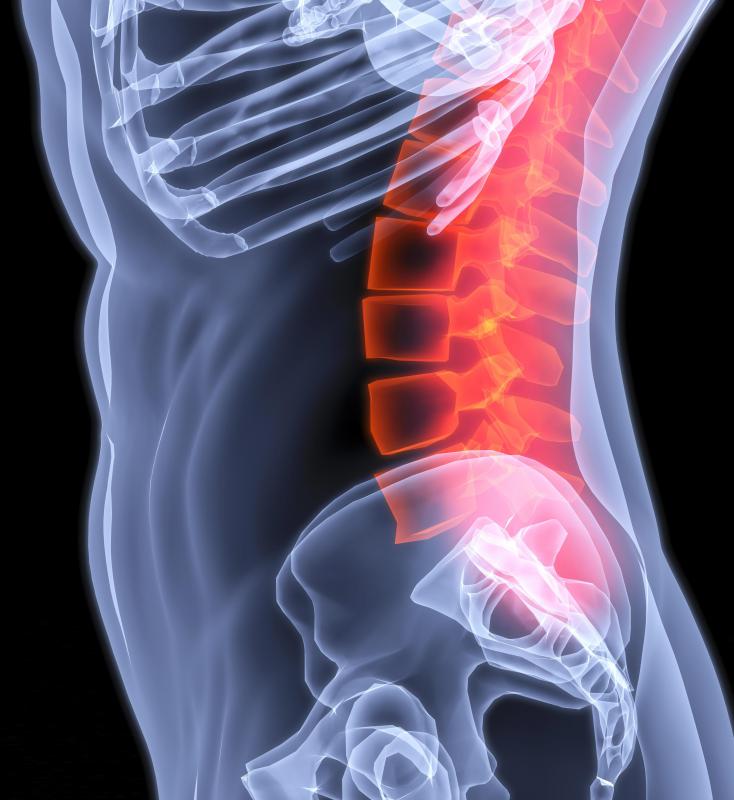At TheHealthBoard, we're committed to delivering accurate, trustworthy information. Our expert-authored content is rigorously fact-checked and sourced from credible authorities. Discover how we uphold the highest standards in providing you with reliable knowledge.
What is Dural Ectasia?
Dural ectasia is a very common symptom associated with Marfan syndrome. This syndrome affects the way connective tissues develop and may have numerous implications for total health. In the case of dural ectasia, part of the spine or brain column called the dura, enlarges. Symptoms resulting from this are dependent on the individual case and the area where widening occurs. Commonly, people may experience some degree of pain, and treatment is directed toward managing pain symptoms.
In most cases, dural ectasia affects the dura in the lower spine, and might include additional features. Some people also develop cysts in the area affected, which may worsen symptoms. It’s believed the condition is most likely to develop in the lower spine because fluid pressure on the dura is highest in these areas. Nevertheless, there may be occasional presentation of the symptoms elsewhere, such as farther up the spine on the neck or upper back.

People with Marfan syndrome are monitored for the possible presence of this condition, and a few other types of conditions can increase risk for the condition. Genetic disorders like neurofibromatosis may sometimes result in a widening or ballooning dura. Another connective tissue disorder, Ehlers-Danlos syndrome is associated with greater likelihood of developing this condition. In most cases, the largest share of cases come from people with Marfan, and there are varying percentages given for just how common it is. Some suggest that over 90% of adults with Marfan might develop this complication, and others believe a more reasonable percentage is roughly 50-60%.

Symptoms of the disorder are highly variable. Some people may have a widened dura and very few symptoms. Others experience conditions like chronic back pain, aching heads, and reduction in movement or sensation in the pelvis, which may lead to difficulties with bowel function. Pain might depend on area where the dura has expanded, and since this is often the lower back, people may describe pain in the buttocks, lower back, tailbone, pelvis, or in the stomach.

When such symptoms present, especially if a person has one of the predisposing conditions mentioned, most doctors order magnetic resonance imaging (MRI) of the spine to confirm or rule out dural ectasia. Other scans are sometimes utilized but studies have shown them to be less accurate in visualizing the problem. Much of the medical community agrees that MRI is the best diagnostic technique.

Given a diagnosis of dural ectasia, treatment depends on symptoms. Depending on symptomatic expression, the type and amount of pain control will vary. Some people have this condition and need very little treatment and others are greatly affected and will require pain management and control. In rare cases, surgery is attempted, but generally, treatment is with pain meds. Extra care does need to be taken if any spinal surgery is attempted in the future because the dura and sometimes the spine become more fragile with this condition.
AS FEATURED ON:
AS FEATURED ON:














Discussion Comments
It sure is a life of rice, hot water bottles and deep heat, conservative measures when possible, and compression clothes for proprioception. For a lot of doctors, there's a lack of understanding or trying to see with fresh eyes. Spotting a rare disease would find a whole lot more of the dazzle. Instead, you become your own doctor, making it harder to seek treatment. Is it bad or your normal pain level? On a scale of better or worse than last time?
Not sure how the other symptoms like weakness and numbness would be handled. Having ballooning of tissue in your spinal cord region would be hard to work on if you are a doctor.
I feel for these poor people with something like this. They can't even stay upright as much as most people because of the pressure this adds to the area pressing. It could be a life changing illness.
Post your comments